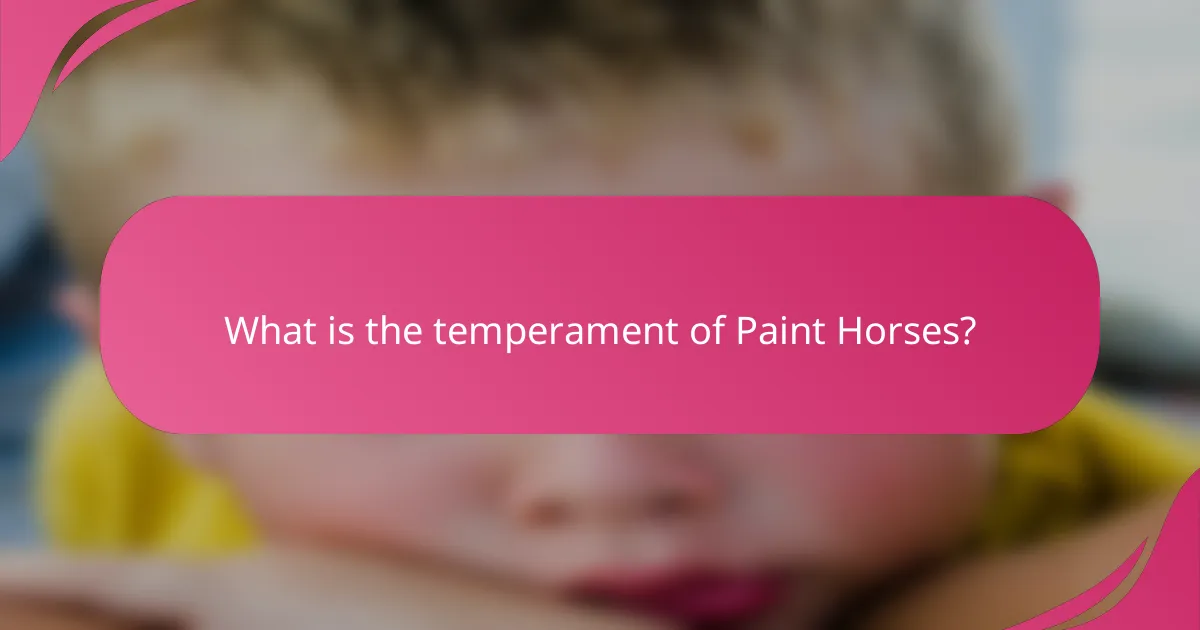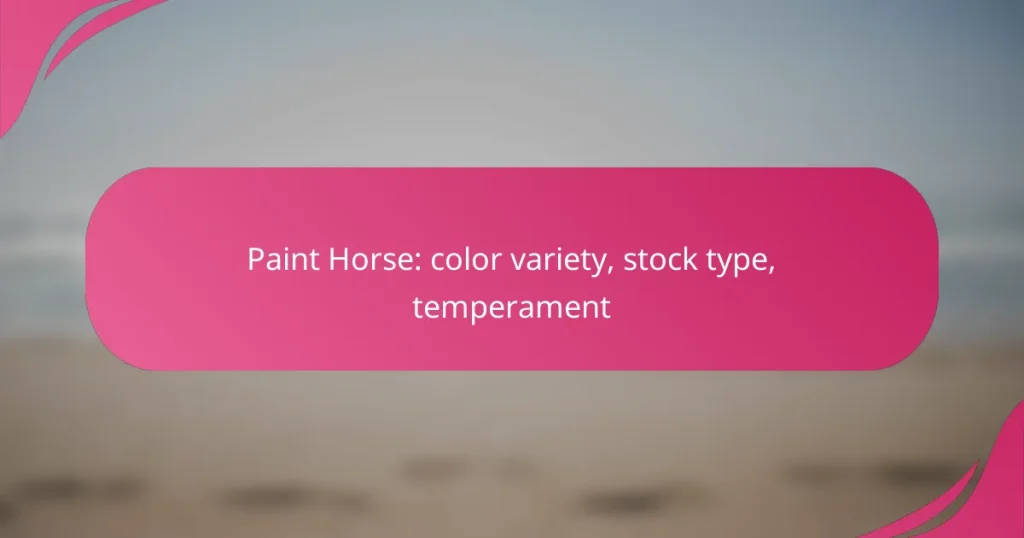Paint Horses are celebrated for their striking coat patterns, which include distinct varieties such as Overo, Tobiano, Tovero, and Solid Paint. These horses come in various stock types tailored for different disciplines, including Western, English, and Foundation. Known for their friendly and gentle temperament, Paint Horses are ideal for riders of all skill levels, making them a popular choice in both recreational and competitive equestrian activities.

What are the color varieties of Paint Horses?
Paint Horses are known for their distinctive coat patterns, which can be categorized into several color varieties. The main types include Overo, Tobiano, Tovero, and Solid Paint, each with unique characteristics and genetic backgrounds.
Overo
Overo Paint Horses are recognized by their irregular, jagged white markings that do not cross the back between the withers and the tail. Their color patterns often feature large patches of color, which can be any combination of black, brown, or chestnut. Overo horses may also have a distinct facial marking, adding to their unique appearance.
Common color combinations in Overo Paints include black and white, bay and white, and chestnut and white. The genetic basis for Overo patterns involves specific genes that influence how the white markings develop on the horse’s coat.
Tobiano
Tobiano Paint Horses display a more symmetrical pattern with white patches that typically cross the back and are often rounded. These horses usually have white legs and a white face, contributing to their striking appearance. The color combinations in Tobiano Paints often include white with any solid color, such as black, brown, or palomino.
The Tobiano pattern is generally more predictable genetically, making it easier for breeders to anticipate the color outcomes in offspring. This predictability can be advantageous for those looking to breed for specific color traits.
Tovero
Tovero Paint Horses exhibit characteristics of both Overo and Tobiano patterns, resulting in a unique combination of markings. They may have the jagged white patterns of Overo along with the rounded patches of Tobiano. This variety can include a mix of colors and patterns, making each Tovero horse distinct.
Tovero horses often have white markings on their faces and bodies that can be quite striking. The genetic makeup of Tovero horses can be complex, as it involves multiple genes that influence both the Overo and Tobiano patterns.
Solid Paint
Solid Paint Horses are those that do not exhibit the traditional Paint patterns but still carry the Paint Horse breed’s genetics. They can be any solid color, such as black, chestnut, or palomino, and may possess the Paint gene without displaying the characteristic markings. This variety is often overlooked but is still a part of the Paint Horse lineage.
Solid Paints can be registered as Paint Horses if they meet specific breed standards, which may vary by registry. Breeders may choose to produce Solid Paints for various reasons, including color preferences or specific performance traits.
Color genetics
The color genetics of Paint Horses is determined by a combination of dominant and recessive genes that dictate coat color and pattern. Understanding these genetics is crucial for breeders aiming to produce specific color varieties. The key genes involved include the white spotting genes, which influence whether a horse will exhibit Overo, Tobiano, or Tovero patterns.
Breeders should consider the genetic background of both the sire and dam when planning a breeding program. Testing for specific genes can provide insights into potential color outcomes, helping to achieve desired results while maintaining the health and conformation of the horses.

What stock types are available for Paint Horses?
Paint Horses come in several stock types, each suited for different disciplines and purposes. The main stock types include Western, English, and Foundation, each with unique characteristics and uses.
Western stock type
The Western stock type of Paint Horses is primarily bred for ranch work and rodeo events. These horses typically possess a muscular build, strong hindquarters, and a calm temperament, making them ideal for tasks like herding cattle and competing in barrel racing.
Common traits include a stocky frame and a variety of coat patterns. When selecting a Western Paint Horse, look for responsiveness and agility, as these qualities enhance performance in Western riding disciplines.
English stock type
English stock type Paint Horses are bred for disciplines such as dressage, show jumping, and eventing. They tend to have a more refined appearance compared to their Western counterparts, with longer legs and a more elegant neck.
These horses are known for their versatility and athleticism. When choosing an English Paint Horse, consider their movement and conformation, as these factors greatly influence their performance in English riding events.
Foundation stock type
Foundation stock type Paint Horses are bred to preserve the original characteristics of the breed, emphasizing conformation and temperament. These horses often exhibit a blend of traits from both Western and English types, making them adaptable for various uses.
Foundation Paints are typically recognized for their strong genetics and are often used in breeding programs to maintain breed standards. When selecting a Foundation Paint Horse, prioritize health and lineage to ensure quality and performance potential.

What is the temperament of Paint Horses?
Paint Horses are known for their friendly and gentle temperament, making them suitable for various riders, from beginners to experienced equestrians. Their sociable nature and intelligence contribute to their popularity in both recreational and competitive settings.
Gentle and friendly
Paint Horses are typically very gentle and friendly, which makes them excellent companions. They often form strong bonds with their owners and enjoy human interaction, making them ideal for families and novice riders.
These horses usually exhibit a calm demeanor, which can help ease the nerves of less experienced riders. Their sociable nature means they often get along well with other horses and animals, creating a harmonious environment in stables or pastures.
Intelligent and trainable
Paint Horses are known for their intelligence, which makes them highly trainable. They quickly learn new commands and skills, allowing for effective training sessions that can be both productive and enjoyable.
When training a Paint Horse, consistency and positive reinforcement are key. They respond well to praise and rewards, making it easier to teach them various disciplines, from Western riding to dressage.
Energetic and playful
Paint Horses possess a lively and playful spirit, which can make them fun to work with. Their energy levels can vary, but they generally enjoy activities that allow them to express their playful nature, such as games or obstacle courses.
However, it’s important to channel their energy appropriately. Regular exercise and mental stimulation are essential to keep them engaged and prevent boredom, which can lead to undesirable behaviors. Engaging them in varied activities can help maintain their enthusiasm and focus.

How to choose a Paint Horse for your needs?
Choosing a Paint Horse involves considering its temperament, color preferences, and stock type suitability to ensure it meets your specific requirements. Assessing these factors will help you find a horse that aligns with your riding style and lifestyle.
Assessing temperament
Temperament is crucial when selecting a Paint Horse, as it affects how the horse interacts with humans and other animals. Generally, Paint Horses are known for their friendly and gentle nature, making them suitable for various riders, from beginners to experienced equestrians.
When evaluating temperament, observe the horse’s behavior in different situations. Look for signs of calmness, curiosity, and willingness to engage. It’s advisable to spend time with the horse before making a decision, as individual personalities can vary significantly.
Evaluating color preferences
Paint Horses are recognized for their striking color patterns, which can range from overo to tobiano and tovero. Your choice may depend on aesthetic preferences or breed standards, especially if you plan to show the horse.
Consider the maintenance of the coat as well; some colors may require more grooming to keep them looking their best. If you have a specific color in mind, research the availability of that color within the Paint Horse breed to ensure you find a suitable match.
Understanding stock type suitability
Paint Horses come in various stock types, primarily categorized into stock-type and pleasure-type. Stock-type Paints are built for strength and agility, making them ideal for cattle work and rodeo events, while pleasure-type Paints are more suited for leisurely riding and show competitions.
When choosing a stock type, consider your intended use for the horse. If you plan to engage in competitive events, a stock-type may be more appropriate. Conversely, for casual riding, a pleasure-type might be the better option. Assessing the horse’s conformation and movement can also provide insights into its suitability for your needs.

What are the common health considerations for Paint Horses?
Paint Horses, like all breeds, have specific health considerations that owners should be aware of. These include genetic disorders, dietary needs, and the importance of regular veterinary care to ensure their overall well-being.
Genetic disorders
Paint Horses can be prone to certain genetic disorders that may affect their health. Common issues include hyperkalemic periodic paralysis (HYPP) and equine polysaccharide storage myopathy (EPSM). It’s crucial for owners to obtain horses from reputable breeders who conduct genetic testing to minimize the risk of these conditions.
Regular screening and awareness of family histories can help identify potential genetic issues early. Owners should consult with veterinarians for advice on managing these disorders if they arise.
Nutrition and diet
A balanced diet is essential for the health of Paint Horses. They require a mix of quality forage, grains, and supplements tailored to their specific needs, depending on their age, activity level, and health status. Regularly assessing their body condition can help guide dietary adjustments.
It’s advisable to consult with an equine nutritionist to create a diet plan that meets the horse’s unique requirements. Avoid overfeeding or underfeeding, as both can lead to health complications.
Regular veterinary care
Regular veterinary care is vital for maintaining the health of Paint Horses. This includes routine vaccinations, dental check-ups, and parasite control. Establishing a consistent schedule with a veterinarian can help catch health issues early.
Owners should also be proactive in monitoring their horse’s behavior and physical condition. Keeping detailed records of veterinary visits and treatments can aid in managing their overall health effectively.

What are the training tips for Paint Horses?
Training Paint Horses effectively requires understanding their unique temperament and characteristics. Consistent, positive reinforcement methods work best for these intelligent and sensitive animals.
Understanding Their Temperament
Paint Horses are known for their friendly and gentle disposition, making them suitable for various riders. They tend to be eager to please, which can facilitate training. However, their sensitivity means that harsh training methods can lead to fear or resistance.
Establishing trust is crucial. Spend time building a bond through groundwork and gentle handling before moving on to more advanced training. This foundation will help them feel secure and responsive during lessons.
Consistent Training Routines
Consistency is key in training Paint Horses. Establish a regular training schedule that includes short, focused sessions lasting around 20 to 30 minutes. This approach helps maintain their attention and prevents fatigue.
Incorporate a variety of exercises to keep the training engaging. Mixing groundwork, riding, and obstacle courses can enhance their skills while preventing boredom. Always end sessions on a positive note to reinforce their willingness to learn.
Positive Reinforcement Techniques
Using positive reinforcement is highly effective with Paint Horses. Reward them with treats, praise, or a gentle pat when they perform desired behaviors. This encourages them to repeat those actions in the future.
Avoid negative reinforcement, as it can damage the horse’s confidence and willingness to cooperate. Instead, focus on redirecting unwanted behaviors and rewarding good ones to foster a positive learning environment.
Socialization and Exposure
Socialization is vital for Paint Horses, as it helps them adapt to different environments and situations. Introduce them gradually to various stimuli, such as other animals, people, and new locations.
Regular exposure to diverse experiences will enhance their confidence and reduce anxiety. Consider taking them to local events or riding with other horses to help them become well-rounded and adaptable.


